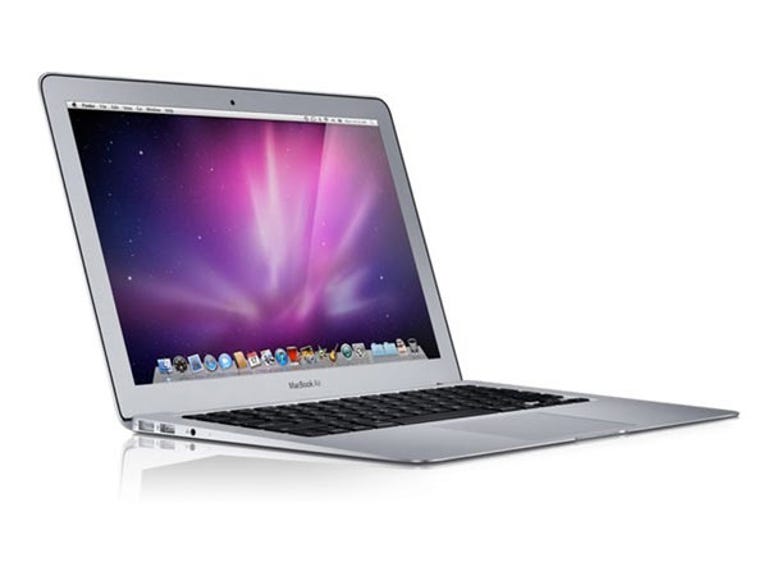 Why You Can Trust CNET
Why You Can Trust CNET Apple MacBook Air 13 (late 2010) review: Apple MacBook Air 13 (late 2010)
Apple's latest MacBook Air adds some much needed ports and pulls some things in line with the MacBook Pro range. It's an excellent travel laptop, but we wish it would have made the transition to Intel's Core i series.
Apple's newest MacBook Air got a nip and tuck, a small tweak to bring it in line with the look of the current MacBook Pro. Nothing rams this point home more than the hardware inside, the fact that it's still running a Core 2 Duo being chief suspect.
The Good
The Bad
The Bottom Line
This is nothing to be ashamed of, of course. Some Windows-based thin-and-light laptops still use the Core 2 Duo as a way to keep heat and cost down (although they're now transitioning to Core i3 and i5), while still being able to achieve the svelte form factor that the MacBook Air pioneered in the first place. This time around though Apple has boosted its 9400M graphics solution to the GeForce 320M, also found in the latest 13-inch MacBook Pro.
Our particular review sample comes with 2GB RAM and a 128GB flash drive. Apple's making a point of not calling it an SSD in its marketing (although OS X's Disk Utility is perfectly happy calling it thus, as is Toshiba).
All this hardware is crammed into a unibody aluminium shell, refined since the last iteration — it has an extra large touch pad, with single button press as per the MacBook Pro. The power button has been moved into the keyboard, sitting right next to the F12 key. The annoying flip down ports are gone, in favour of directly exposing them to the outside for easy access.
There are now two USB ports instead of one, a headphone jack, SD card reader and Mini DisplayPort out. Sadly, it doesn't inherit the backlit keyboard or edge-to-edge glass of the MacBook Pro, and there's no dedicated microphone jack or Ethernet — all features that we feel would push the Air into true luxury zone. Admittedly, it'd likely also drive up the price and push the Air into the unattainable zone for many as well.
And that's the new Air — while there's a little more expansion than the last version, this is still a device of minimalism. The difference is when the first Air was released, we pined the lack of optical drive, bemoaned the single USB port and admonished the performance — now, in a post-netbook world, the Air makes more sense than it once did, and provides a better experience than any netbook ever could. Thankfully, Apple has also included OS X on a USB flash drive, rather than a disc.
This is a laptop, though, that's built for mobility. At AU$1599 for the base model, it is admittedly around three times more than a netbook — but significantly cheaper than its predecessors.
The bigger keyboard, 13.3-inch, 1440x900 screen (that's right folks, except for the 11.6-inch MacBook Air, Apple is still sticking to 16:10) and a fantastic battery life means that for the frequent traveller, we think the Air makes much more sense than a netbook's cramped conditions, despite the significantly larger outlay. In the end, it'll depend on your wallet.
The obvious question also arises: with a price so close to the MacBook Pro, which gives much better hardware, why wouldn't you opt for the bigger brother instead?
Once again, it's the travel capability of the Air. If you're not moving much, then the Pro makes more sense, it simply offers more for less money. If you are hitting the road a lot though, and don't have crazy production requirements, the maximum thickness of the Air at 17mm compared to the Pro's 24.1mm and 1.32kg compared to 2.54kg begins to make sense.
Performance
(Shorter bars indicate better performance)
(Shorter bars indicate better performance)
(Shorter bars indicate better performance)
(Longer bars indicate better performance)
By and large, performance on the 13-inch MacBook Air was excellent, although we ran into issues with the Air not automatically resuming our Wi-Fi connection after being woken from sleep. It seems we're not the only ones experiencing Wi-Fi drop out issues, and hope a new driver will be issued soon.
While it may not have the CPU grunt of the Toshiba Portege R700 or the Asus PL30Jt, the MacBook Air 13 has buckets of battery life, a decent GPU and frankly feels nice to use. If you're looking for something light and travel worthy, but with still enough performance to make computing enjoyable, the MacBook Air 13 is something you should definitely look into.


